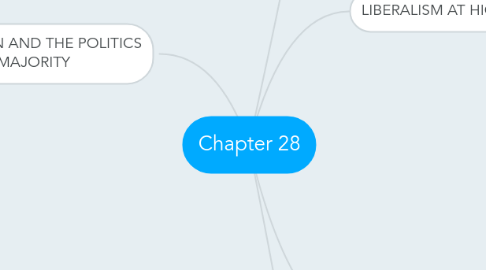Chapter 28
作者:chaley landa

1. THE VIETNAM WAR BEGINS
1.1. Kennedy did not want to loose credibility by withdrawing from Vietnam Escalation Under Johnson “I’m not going to be the President who saw Southeast Asia go the way China went” Gulf of Tonkin In August, 1964, there was a report that a US ship was attacked in international waters by the North Vietnamese; gave LBJ a reason to escalate the war
1.2. The New American Presence Operation Rolling Thunder: Bombing campaign against North Vietnam in 1965 More bombs were dropped on Vietnam than Europe and Asia during WWII The North Vietnamese continued to resist and increased their morale
1.3. Public Opinion and the War “Credibility gap” - writers began to expose that the realities of the war were different than what the administration portrayed Rise of the Student Movement Students for a Democratic Society (SDS) - founded in Michigan by students that sought social change Port Huron Statement - criticized the gap between the rich and poor, as well as the nation’s consumer culture The New Left: Different than the Old Left - associated with Communism Focused
1.4. Young Americans for Freedom Young Americans for Freedom (YAF) - conservative response to the New Left “The Sharon Statement” written before the Port Huron Statement, inspired many conservatives The Counterculture (New curriculum) “Hippies” Inspired by folk music, later the Beatles, Rolling Stones, etc. Rejected
2. DAYS OF RAGE, 1968 - 1972
2.1. War Abroad, Tragedy at Home The Tet Offensive January 30, 1968 - Vietnamese New Year Surprise attack by the North on the South Although the North was defeated, it was a watershed event in the war Many began to see the war as un-winnable, protests increased drastically Political Assassinations
2.2. The Antiwar Movement and the 1968 Election Democratic Convention Chicago, 1968 - demonstrations outside the convention were broken up by police with clubs and tear gas Richard Nixon Nixon focused on northern working class workers and southern whites George Wallace Advocated “law and order” Ran as a third party candidate on a segregationist platform
2.3. The Nationalist Turn Chicano Moratorium Committee - Mexican Americans protesting the Vietnam War Argued that the draft hurt the poor Women’s Liberation Feminists tended to by younger, educated, and associated with the civil rights and antiwar movements Some radical women sought to gain feminist goals through politics Sexual politics - advocated that women must have control over their bodies in order to shape their destinies Focused on access to abortion and awareness for sexual assault and sexual harassment
2.4. Stonewall and Gay Liberation Homosexuality remained illegal in many states Stonewall Inn - gay bar in NYC that was raided by police Led to riots over a two day period
3. RICHARD NIXON AND THE POLITICS OF THE SILENT MAJORITY
3.1. Silent Majority - Nixon’s belief that many Americans supported his beliefs and the war Nixon in Vietnam “Peace with Honor” - Nixon sought to end the Vietnam War, but only in a way satisfactory to the US Vietnamization and Cambodia Vietnamization - gradual withdrawal of US troops from Vietnam, by being replaced with South Vietnamese troops April, 1970 - US began bombing supply lines and bases in neighboring, neutral Cambodia This led to many protests on college campuses, most notably, Kent State
3.2. Detente (New Curriculum) Easing of Cold War tensions between the US and Soviet Union Strategic Arms Limitation Treaty (SALT I) - signed by Nixon and Brezhnev February 21, 1972 visit to China Nixon sought to gain an advantage over the Soviet Union and help end the Vietnam War Exit America Election of 1972 - Nixon campaigned on “Peace at hand”
3.3. The Silent Majority Speaks Out Law and Order and the Supreme Court Warren Court - 1954 - 1969 Accused of “legislating from the bench”, rights of the accused increased Miranda v. Arizona - People must be made aware of the right to remain silent (5th amendment) Sanctioned religious practices in public schools were prohibited Busing In the 1950s, schools were ordered to desegregate with “all deliberate speed”
3.4. The 1972 Election Many southern whites switched to the Republican Party Nixon v. George McGovern (D, ND) Nixon won in a landslide
4. LIBERALISM AT HIGH TIDE
4.1. Great Society: Focus on domestic programs including: civil rights, poverty, and education Built on ideas and programs laid forth from The New Deal John F. Kennedy’s Promise: Kennedy proposed health insurance for the elderly, antipoverty, tax cuts, and a civil rights bill. JFK helped demonstrate the power of image Lyndon B. Johnson and the Great Society: LBJ
4.2. The 1964 Election: (Check out my video) LBJ v. Barry Goldwater (R, AZ) Goldwater opposed Great Society programs and advocated a tougher Cold War stance Ronal Reagan’s “A Time for Choosing” - supported Goldwater at the 1964 Republican convention Great Society Initiatives: Elementary and Secondary Education Act - $1 billion in federal money Medicare - health insurance for elderly Medicaid - health insurance for lower income individuals and families
4.3. Assessing the Great Society Health care for poor and elderly increased Poverty rate for African Americans decreased Poverty and segregation remained in many areas Rebirth of the Women’s Movement Labor Feminists 1960s
4.4. Betty Friedan and the National Organization for Women (NOW) The Feminine Mystique - Betty Friedan Argued that many housewives in suburbs were not happy and lived unfulfilled lives Birth Control Pill - led to the decline in birthrates, end of the baby boom generation National Organization for Women (NOW)
5. LIBERALISM AT HIGH TIDE, CONTINUED


